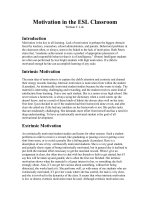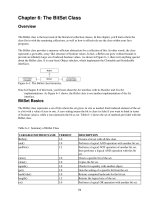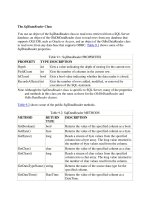The SqlCommand Class
Bạn đang xem bản rút gọn của tài liệu. Xem và tải ngay bản đầy đủ của tài liệu tại đây (21.87 KB, 3 trang )
The SqlCommand Class
You use an object of the SqlCommand class to execute a command against a SQL Server
database, an object of the OleDbCommand class to execute a command against any
database that supports OLE DB, such as Oracle or Access, and an object of the
OdbcCommand class to execute a command against any database that supports ODBC.
Table 8.1
shows some of the SqlCommand properties. Table 8.2 shows some of the
SqlCommand methods. You'll learn how to use some of these properties and methods in
this chapter.
Table 8.1: SqlCommand PROPERTIES
PROPERTY TYPE DESCRIPTION
CommandText string Gets or sets the SQL statement, stored
procedure call, or table to retrieve from.
CommandTimeout int Gets or sets the number of seconds to wait
before ending an attempt to execute the
command. The default is 30 seconds.
CommandType CommandType Gets or sets a value that indicates how the
CommandText property is to be
interpreted. Valid values are
CommandType.Text, CommandType
.StoredProcedure, and CommandType
.TableDirect. Text indicates the command
is a SQL statement. StoredProcedure
indicates the command is a stored
procedure call. TableDirect indicates the
name of a table, for which all rows and
columns are to be retrieved. The default is
Text.
Connection string Gets the name of the database connection.
DesignTimeVisible bool Gets or sets a Boolean value that indicates
whether the Command object is visible in a
Windows Forms Designer control. The
default is false.
Parameters SqlParameterCollection Gets the parameters (if any) to supply to
the command. When using a
SqlConnection, the parameters are stored in
a SqlParameterCollection object.
Transaction SqlTransaction Gets or sets the database transaction for the
Table 8.1: SqlCommand PROPERTIES
PROPERTY TYPE DESCRIPTION
command.
UpdatedRowSource UpdateRowSource Gets or sets how the command results are
to be applied to a DataRow object when the
Update() method of a DataAdapter object is
called.
Table 8.2: SqlCommand METHODS
METHOD RETURN
TYPE
DESCRIPTION
Cancel() void Cancels the execution of the command.
CreateParameter() SqlParameter Creates a new parameter for the command.
ExecuteNonQuery() int Used to execute SQL statements that don't
return a result set. These statements include
INSERT, UPDATE, and DELETE
statements, Data Definition Language
statements, or stored procedure calls that don't
return a result set. The int value returned is
the number of database rows affected by the
command, if any.
ExecuteReader() SqlDataReader Used to execute SQL SELECT statements,
TableDirect commands, or stored procedures
that return a result set. Returns the result set
in a DataReader object.
ExecuteScalar() object Used to execute SQL SELECT statements
that return a single value (any other values are
ignored). Returns the result of the command
as an object.
ExecuteXmlReader() XmlReader Used to execute SQL SELECT statements
that return XML data. Returns the result set in
an XmlReader object. Applies only to the
SqlCommand class.
Prepare() void Creates a prepared version of the command.
Sometimes results in faster execution of the
command.
ResetCommandTimeout() void Resets the CommandTimeout property to its
default value.
Note Although the SqlCommand class is specific to SQL Server, many of the properties
and methods in this class are the same as those for the OleDbCommand and
OdbcCommand classes. If a property or method is specific to SqlCommand, it says
so in the Description column of the tables shown in this section.
Tip You're actually better off using the T-SQL EXECUTE command rather than
CommandType.StoredProcedure to execute a stored procedure. This is because you
can read values that are returned from a stored procedure through a RETURN
statement, which you can't do when setting the CommandType to StoredProcedure.
See the section "Executing SQL Server Stored Procedures
" later in this chapter.









